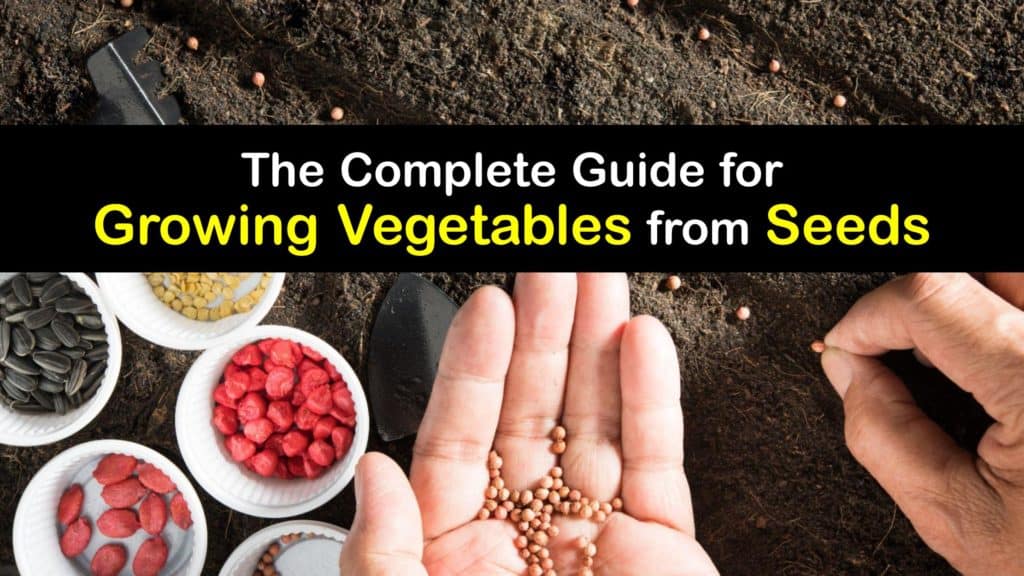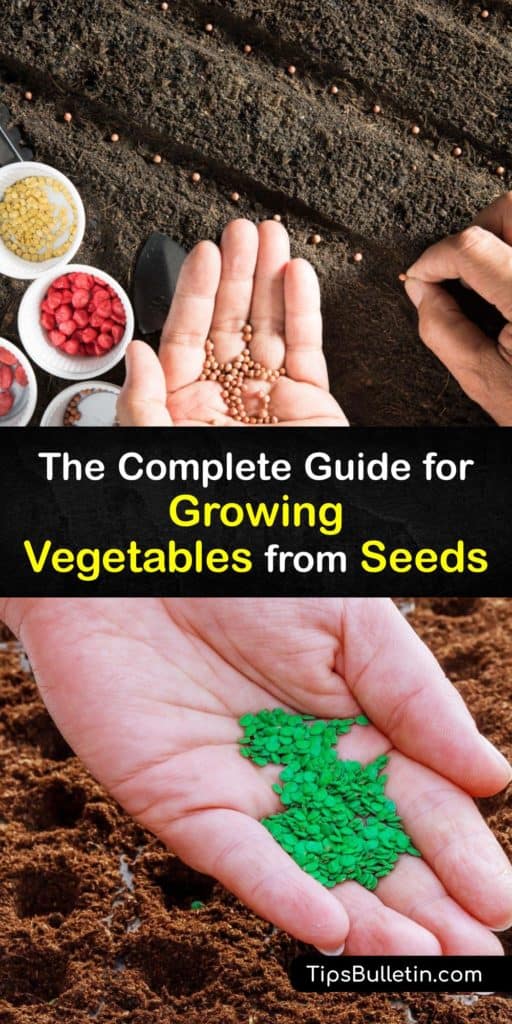Vegetable gardening is a challenging and rewarding experience for anyone, whether they have space in the garden for new plants or not. This article covers how to grow vegetables from seeds, including the best times for planting seeds to ensure germination.
Along with growing vegetables from seeds, gardeners can grow plants from cuttings or starts, usually purchased from a nursery. These additional options are essential for gardeners because using a start cuts some of the required growing time for plants to reach maturity.
Timing is crucial if you’re growing vegetables in a zone that is not entirely suitable for your desired crop or competing with short growing seasons. Despite the benefit of planting vegetables from cuttings, direct sowing with seeds remains the most popular method for growing veggies.

Growing Vegetables from Seeds
Because different vegetables have specific growing requirements, if you’re new to growing vegetables from seeds, start with a few of your favorite crops. Sow heirloom seeds to grow types of vegetables that may have built-in disease resistance. Planting vegetables from seeds also allows you to start growing plants indoors in containers or seed trays to transplant these crops later.
A good time to plant vegetables really depends on the veggie or fruit you want to grow. Watermelons have different growing requirements from what Brussels sprouts tolerate during their growing season. Growing shallots from seed is not the same as planting tomatoes. Focusing on one plant or family of plants is essential for mastering growing plants from seeds.
Planting Vegetable Seeds
When you sow seeds directly into garden beds, like if you want to germinate carrot seeds fast, prepare the garden soil so that the conditions in your vegetable garden are optimal for seed growth. Different vegetables have specific growing needs in weather, temperature, and soil conditions.
Soil texture and the amount of sand, silt, and clay all determine what best grows in your garden. Many describe soil quality as poor or good in its texture, organic matter content, nutrient levels, and pH.

Having poor soil means the soil in the garden bed contains low organic matter levels with an unbalanced nutrient level. Poor quality also refers to soil with a pH unsuitable for most plants (6.2-6.8).
Although many popular vegetables like beans, peppers, and tomatoes grow well in poor soil, amend the quality of your soil with fertilizers and vermiculite to help plants grow. Local Cooperative Extensions also perform soil tests to determine soil quality to assist in finding plants that thrive in your garden, whether you want to plant cabbage seeds or squash.
When planting seeds indoors or in containers, it is easier to control the condition of the potting mix and the amount of water and sunlight your plants receive. If you start seeds indoors, the goal is to care for your seeds in a controlled environment before introducing them to their outdoor growing conditions.
How to Plant Vegetable Seeds in Containers
To determine if seed starting should begin outside or indoors, check the seed packet. It’s easy to start kale seeds indoors but not all plants are the same. The packaging on many plants encourages you to sow directly into the garden. Some vegetables like radishes should be planted directly into the garden bed because they germinate quickly, but your ability to sow into the garden may vary by climate.
If you’re growing vegetables from seeds in a container, picking the right pot is the first start. Vegetable gardening containers must meet certain requirements for success. Select a pot made from the material of your choice with good drainage holes.
Some plants thrive in a specific container like a glazed clay pot, while others are best grown in peat pots that decompose when put into the ground.
The second option is beneficial for plants susceptible to stress when their roots are disturbed. When planting vegetables from seeds in containers, fill the container with potting soil like perlite and water your seeds thoroughly to encourage them to begin sprouting.
If you’re new to growing vegetables, skip buying a gardening pot and recycle a plastic container from your kitchen. Ideal containers include large yogurt containers, ice cream gallons, or plastic jars.
Cut off or remove the lid and cut drainage holes from the bottom to allow water to drain without causing your potting mix to fall out. Fill your container with soil mix and press your seeds into the soil before covering and watering thoroughly until the water drains through the bottom.
When to transplant crops depends on the growth of your plant and the weather conditions. Most gardeners who plant seeds indoors start a few weeks before the last frost date in their area for plants that cannot handle frost or cold temperatures.
Usually, by this time, once the threat of frost passes, seedlings develop a set of true leaves and are ready to start transplanting to the garden. When to plant vegetable seeds is crucial because the wrong weather conditions prevent seeds from sprouting or may kill a developing plant.
Before planting vegetables grown from seeds into the outdoor garden or allowing them to remain outside to grow, a hardening off period is required. Hardening off involves leaving young plants outdoors for an hour or so a day, adding an hour each day, until your plants spend six to seven hours in their outdoor growing conditions to acclimate them to the outdoors.
How to Plant Vegetable Seeds Outside
Spacing is crucial when you plant seeds directly into the garden. A typical rule of thumb is to sow seeds with even spacing. As the plants grow and develop a set of leaves, gardeners remove every other seedling or the weakest-looking sprouts to give the remaining plants the best chance at maturing.
After seeding the garden, placing black plastic wrap over the seeds is an easy way to increase soil temperature. If you plant your seeds in a full sun location, the sunlight warms the plastic and keeps the soil temperature warm enough to encourage germination.
Creating furrows in your garden is an efficient way to help irrigate your crops easily. Furrows are long trenches through your garden, typically with rows of crops planted between them. When moisture pools in these furrows, the water fills the furrow and evenly adds water to the surrounding soil.
Growing vegetables in soilless beds is an option to avoid soil-borne diseases and conditions like damping off. Soilless mixes offer the ability to mix ingredients to aid with drainage and nutrition. Most soilless mixes come with peat moss that drains well.
If you’re growing vegetables in containers or outdoor beds off the ground, a soilless mix is beneficial when it comes time to harvest crops like potatoes. Mixes made with peat moss are much lighter than traditional potting soil.
How to Grow Vegetables from Seeds
Despite the differences among vegetables, sunlight and water are two conditions that are fairly common across all crops. Most crops require full sun to reach maturity, at least six hours of sunlight per day. Some crops tolerate growing in partial shade and may even thrive if the sun is making the plants too hot.
The best place to leave your containers for planting growing indoors is on a sunny windowsill. If an awning or trees prevent sunlight from reaching your potted plants, consider using a grow light.
Grow lights use LED lights to imitate natural light for indoor plants. Place your plants under the lights to replicate the experience of growing under the sun. This triggers photosynthesis in plants and allows them to grow as long as they are watered and cared for like any outdoor plant.
Plants grown in containers tend to lose moisture faster than plants outside. Regularly check the soil around your plants to see if it’s dry. Not every crop has the same water requirements, but watering once a week is a safe bet. For specific plant maintenance needs, contact a local garden center or extension to find information on how to care for your own plants.
Among the easiest vegetables to grow indoors from seed are lettuce and tomatoes – as long as their growing requirements are met. Experiment to see what works best for you.
Learning how to plant vegetable seeds is simple with simple items and tools. Once you’ve mastered growing plants, harvest and reuse seeds to grow veggies from your own seeds.

If you learned how to grow vegetables from seeds with help from our guide, please share our tips on how to plant vegetable seeds on Facebook and Pinterest.